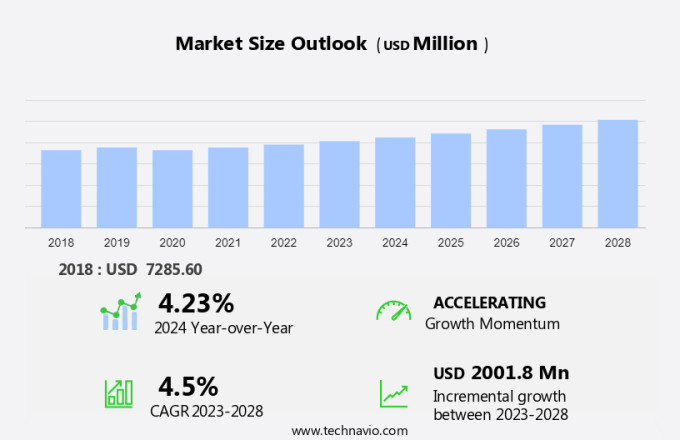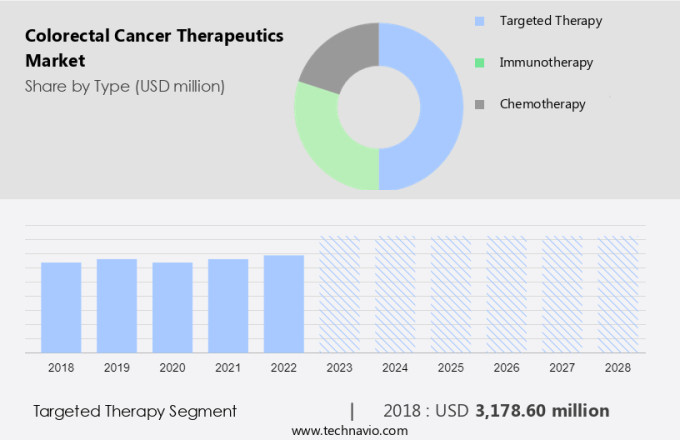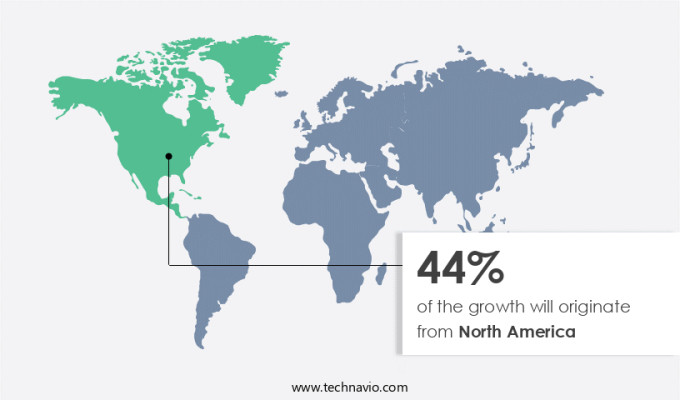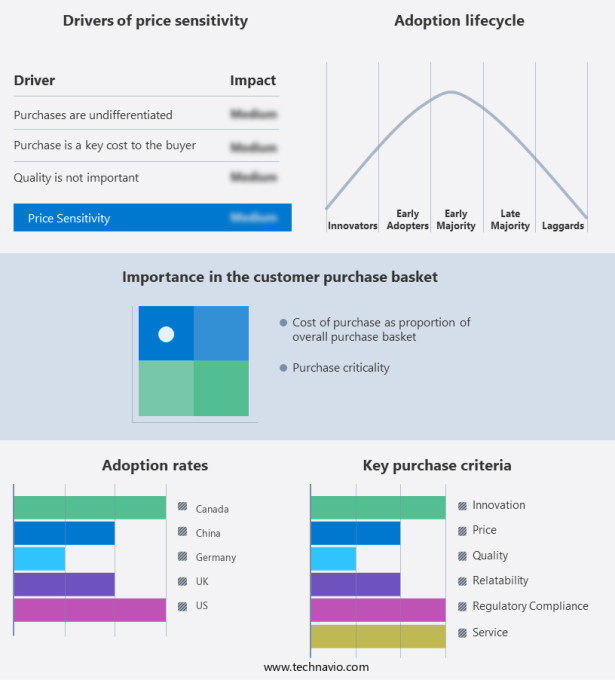Colorectal Cancer Therapeutics Market Size 2024-2028
The colorectal cancer therapeutics market size is forecast to increase by USD 2 billion at a CAGR of 4.5% between 2023 and 2028.
- The market is experiencing significant growth due to several key factors. The increasing geriatric population, with an accompanying rise in colorectal cancer cases, is a major driver for market expansion. Additionally, the development of small molecule kinase inhibitors is revolutionizing treatment approaches and providing new opportunities for market growth.
- Furthermore, the patent expiration of novel therapeutics is leading to increased competition and price erosion, but also fostering innovation and the introduction of more affordable treatment options. These trends and challenges are shaping the future of the market, offering both opportunities and challenges for market participants.
What will be the Size of the Market During the Forecast Period?

Request Free Sample
- Colorectal cancer, also known as colon or rectal cancer, is a significant health concern worldwide. According to the American Cancer Society, colorectal adenocarcinoma accounts for the majority of colorectal cancer cases. Gastrointestinal carcinoid tumors are less common but can also contribute to this disease's burden. The market is witnessing substantial growth due to the increasing incident cases and advancements in treatment modalities. Dana-Farber Cancer Institute reports that young-onset colorectal cancer cases have been rising, highlighting the need for more effective therapies. Targeted therapies and immunotherapies are emerging as promising treatment options for colorectal cancer. Avastin (bevacizumab) and Erbitux (cetuximab) are monoclonal antibodies that have shown efficacy in colorectal cancer treatment by inhibiting angiogenesis and EGFR signaling, respectively. Stivarga (regorafenib) is another multi-kinase inhibitor that targets various tyrosine kinases and has been approved for the treatment of metastatic colorectal cancer. Hospital pharmacies, retail pharmacies, and online pharmacies play crucial roles in the distribution of these therapies. The aging population's increasing prevalence and the need for personalized treatment plans have led to a surge in mutation testing for colorectal cancer.
- Additionally, diagnosis rates continue to rise due to early detection initiatives and advancements in diagnostic technologies. Key oncology analysts, such as Thomas Wales from MSD, predict that the patent expiries of major colorectal cancer drugs, like Avastin and Erbitux, will lead to increased competition in the market. Genentech's Keytruda (pembrolizumab) and Tecentriq (atezolizumab) are among the immunotherapies gaining popularity due to their potential to offer long-term benefits for certain patient populations. In conclusion, the market is witnessing significant growth due to the rising incident cases, aging population, and advancements in targeted therapies and immunotherapies. The distribution landscape is evolving, with hospital pharmacies, retail pharmacies, and online pharmacies playing essential roles. The market dynamics are complex, with patent expiries and emerging competitors influencing the competitive landscape.
How is this market segmented and which is the largest segment?
The market research report provides comprehensive data (region-wise segment analysis), with forecasts and estimates in "USD billion" for the period 2024-2028, as well as historical data from 2018-2022 for the following segments.
- Type
- Targeted therapy
- Immunotherapy
- Chemotherapy
- Geography
- North America
- Europe
- Asia
- Rest of World (ROW)
By Type Insights
- The targeted therapy segment is estimated to witness significant growth during the forecast period.
Colorectal cancer (CRC) is a leading cause of cancer-related deaths worldwide. Targeted therapies, which inhibit cancer-causing genes, proteins, or receptors, have emerged as an effective treatment option for CRC. Some targeted therapies used in CRC treatment include bevacizumab (Avastin), regorafenib (Stivarga), ziv-aflibercept (Zaltrap), ramucirumab (cyramza), cetuximab (ERBITUX), and panitumumab (Vectibix). Regorafenib, in particular, is an anti-angiogenic agent that has shown success in treating CRC with the BRAF V600E mutation through its BRAFTOVI form. Hospital, retail, and online pharmacies distribute these therapeutics. Pipeline analysis indicates ongoing research and development for new CRC therapeutics. The regulatory scenario is favorable for the market's growth, with the National Library of Medicine providing extensive resources for CRC research.

Get a glance at the market report of share of various segments Request Free Sample
The targeted therapy segment was valued at USD 3.18 billion in 2018 and showed a gradual increase during the forecast period.
Regional Analysis
- North America is estimated to contribute 44% to the growth of the global market during the forecast period.
Technavio's analysts have elaborately explained the regional trends and drivers that shape the market during the forecast period.

For more insights on the market share of various regions Request Free Sample
The North American region held the largest market share in The market in 2023, driven by high incidence rates. According to the American Cancer Society, approximately 153,020 colorectal cancer (CRC) cases were diagnosed, resulting in 52,550 deaths, with a significant number of cases and fatalities occurring in individuals under 50 years old. This high prevalence of CRC is anticipated to fuel market growth in the region. Additionally, increasing awareness about colorectal cancer in major countries such as the US and Canada is another significant factor contributing to market expansion. Targeted therapies, such as Cotellic and Fruquintinib, which are used to treat CRC with specific genetic mutations like KRAS, are gaining popularity due to their effectiveness. However, patent expiries of certain blockbuster drugs may pose a challenge to market growth during the forecast period.
Market Dynamics
Our researchers analyzed the data with 2023 as the base year, along with the key drivers, trends, and challenges. A holistic analysis of drivers will help companies refine their marketing strategies to gain a competitive advantage.
What are the key market drivers leading to the rise in adoption of Colorectal Cancer Therapeutics Market?
Increasing geriatric population is the key driver of the market.
- The colorectal cancer therapeutics market is driven by the increasing incidence of colorectal cancer, particularly in the aging population. According to the Centers for Disease Control and Prevention (CDC), over 90% of colorectal cancer cases occur in individuals aged 50 and above. The global geriatric population is projected to grow from 9.3% in 2020 to approximately 17% by 2050, and the US Census Bureau anticipates a rise in the population aged 65 and above to 1,566 million by 2050. This demographic shift is expected to result in a significant increase in the number of colorectal cancer cases. Colorectal cancer, also known as colon or rectal cancer, is the third most common cancer in the US. Colorectal adenocarcinoma and gastrointestinal carcinoid are the most common types of colorectal cancer. Mutations in genes such as KRAS, BRAF V600E, and microsatellite instability play a role in the development of colorectal cancer. The market for colorectal cancer therapeutics includes targeted therapies, immunotherapies, and chemotherapies. Targeted therapies, such as Avastin (bevacizumab) and Erbitux (cetuximab), inhibit the growth of cancer cells by targeting specific proteins.
- Additionally, immunotherapies, such as Keytruda (pembrolizumab) and Tecentriq (atezolizumab), harness the power of the immune system to fight cancer. Chemotherapies containing 5-FU, Capecitabine, and Oxaliplatin are commonly used for colorectal cancer treatment. The regulatory scenario for colorectal cancer therapeutics is favorable, with the FDA approving several new drugs in recent years. For instance, BRAFTOVI (encorafenib) and Cetuximab were approved for the treatment of BRAF V600E mutant colorectal cancer, and Fruquintinib was approved for the treatment of metastatic colorectal cancer with RAS wild-type and left-sided metastases. Hospital pharmacies, retail pharmacies, and online pharmacies are the major distribution channels for colorectal cancer therapeutics. The pipeline analysis of the market includes several promising drugs, such as Akeda's AKD-1228, Hutchmed's Fruquintinib, Roche's Cotellic, and Mirati Therapeutics' Krazati.
- In conclusion, the market also faces challenges, including the high cost of drugs and the need for mutation testing for personalized treatment. In conclusion, the colorectal cancer market is expected to grow significantly due to the increasing incidence of colorectal cancer in the aging population. The market includes targeted therapies, immunotherapies, and chemotherapies, and the regulatory scenario is favorable for new drug approvals. The distribution channels include hospital pharmacies, retail pharmacies, and online pharmacies, and the pipeline analysis includes several promising drugs. The challenges include the high cost of drugs and the need for mutation testing for personalized treatment.
What are the market trends shaping the Colorectal Cancer Therapeutics Market?
The development of small molecule kinase inhibitors is the upcoming trend in the market.
- The market is witnessing significant advancements, with a focus on developing safe, effective, and affordable treatments for colorectal adenocarcinoma and other forms of colorectal cancer, including gastrointestinal carcinoid. Protein kinases play a crucial role in the development of colorectal cancer as they catalyze the phosphorylation of cellular substrates, regulating various cellular processes. However, under pathological conditions, protein kinases can be deregulated, leading to uncontrolled cell division and inhibition of apoptosis, among other abnormalities. Several pharmaceutical companies are exploring the development of small molecule drugs that inhibit these deregulated protein kinases. These drugs offer advantages over biologics, which have high development costs and associated side effects. The majority of these small molecules target tyrosine kinases and other protein kinases, inhibiting their activity and preventing the progression of colorectal cancer. The market dynamics for colorectal cancer therapeutics are influenced by various factors, including the aging population, increasing diagnosis rates, and unmet medical needs. Mutation testing, particularly for mutations such as BRAF V600E, plays a significant role in the identification of potential treatment options.
- Additionally, targeted therapies, such as Avastin, Erbitux, Stivarga, and others, have shown promising results in the treatment of colorectal cancer. Regulatory scenarios, such as those set by the FDA, and pipeline analysis are essential factors influencing the market's growth. Hospital pharmacies, retail pharmacies, and online pharmacies are key distribution channels for these therapeutics. The use of biosimilars is also gaining traction, offering cost savings without compromising efficacy. The market for colorectal cancer therapeutics is expected to grow, driven by the increasing incidence of colorectal cancer and the unmet medical need for safe, effective, and affordable treatment options. Microsatellite instability, a biomarker for certain types of colorectal cancer, is also gaining attention as a potential target for new treatments.
- In conclusion, companies such as Dana-Farber, MSD, Roche, Hutchmed, and Mirati Therapeutics are among those actively researching and developing new treatments for colorectal cancer. Despite the promising developments, challenges remain, including the tolerability of chemotherapies containing serious adverse events and the high discontinuation rates due to side effects. NRAS mutants and other mutations also pose a challenge, necessitating the development of new and effective treatments. The use of biomarkers for personalized medicine and the development of immunotherapies, such as Keytruda, are potential solutions to these challenges. Overall, the market is poised for growth, driven by the increasing incidence of colorectal cancer and the unmet medical need for safe, effective, and affordable treatment options.
What challenges does Colorectal Cancer Therapeutics Market face during the growth?
Patent expiration of novel therapeutics is a key challenge affecting the market growth.
- The market is significantly impacted by the expiration of patents on key biologics, such as Avastin (bevacizumab), Vectibix (panitumumab), and Zaktrap (ziv-Aflibercept). According to the World Trade Organization's TRIPS agreement, innovators are granted exclusive patent rights for 20 years from the date of application filing in the US and Europe. Once these patents expire, biosimilars can enter the market, increasing competition and decreasing the price of the original biologic therapeutics. Colorectal cancer, also known as colorectal adenocarcinoma, is a major health concern with a high incidence rate, particularly in the aging population. YoungOnset Colorectal cancer is also on the rise, increasing the unmet need for effective therapeutics. The diagnosis rates and incident cases of colorectal cancer are increasing, leading to a growing demand for targeted therapies, immunotherapies, and chemotherapies. Targeted therapies, such as those that inhibit tyrosine kinase, are gaining popularity due to their high efficacy and tolerability.
- Additionally, mutation testing, specifically for mutations such as BRAF V600E, is crucial in determining the most effective treatment. The regulatory scenario for colorectal cancer therapeutics is complex, with ongoing pipeline analysis and frequent updates from regulatory bodies like the FDA. The CRC (Colorectal Cancer) market includes a range of drug classes, including monoclonal antibodies, tyrosine kinase inhibitors, and chemotherapies containing serious adverse events such as discontinuation due to intolerability. The market is expected to be influenced by the regulatory scenario, incidence rates, and unmet need for effective treatments. Companies such as Dana-Farber, MSD, Roche, Hutchmed, and Mirati Therapeutics are actively researching and developing new therapeutics for colorectal cancer.
- In conclusion, microsatellite instability (MSI) is a biomarker that can help identify patients who may benefit from immunotherapies such as Keytruda (pembrolizumab) and Tecentriq (atezolizumab). The use of biosimilars for chemotherapies is also expected to increase, particularly for older patients and those with financial constraints. The market for colorectal cancer therapeutics is expected to remain dynamic, with ongoing research and development, patent expirations, and regulatory updates.
Exclusive Customer Landscape
The market forecasting report includes the adoption lifecycle of the market, covering from the innovator's stage to the laggard's stage. It focuses on adoption rates in different regions based on penetration. Furthermore, the market report also includes key purchase criteria and drivers of price sensitivity to help companies evaluate and develop their market growth analysis strategies.

Customer Landscape
Key Companies & Market Insights
Companies are implementing various strategies, such as strategic alliances, market forecast, partnerships, mergers and acquisitions, geographical expansion, and product/service launches, to enhance their presence in the market. The market research and growth report includes detailed analyses of the competitive landscape of the market and information about key companies, including:
- Accord Healthcare Ltd.
- Amgen Inc.
- Amneal Pharmaceuticals Inc.
- Bayer AG
- Biocon Ltd.
- Bristol Myers Squibb Co.
- CK Hutchison Holdings Ltd.
- Eli Lilly and Co.
- F. Hoffmann La Roche Ltd.
- Fresenius SE and Co. KGaA
- Hetero Drugs Ltd.
- Hikma Pharmaceuticals Plc
- Merck and Co. Inc.
- Ono Pharmaceutical Co. Ltd.
- Otsuka Holdings Co. Ltd.
- Pfizer Inc.
- Sanofi SA
- Sun Pharmaceutical Industries Ltd.
- Teva Pharmaceutical Industries Ltd.
- Viatris Inc.
Qualitative and quantitative analysis of companies has been conducted to help clients understand the wider business environment as well as the strengths and weaknesses of key market players. Data is qualitatively analyzed to categorize companies as pure play, category-focused, industry-focused, and diversified; it is quantitatively analyzed to categorize companies as dominant, leading, strong, tentative, and weak.
Research Analyst Overview
The market represents a significant and growing sector within the healthcare industry. This market encompasses a range of treatments for various types of colorectal cancers, including colorectal adenocarcinoma and gastrointestinal carcinoid. The market is driven by the increasing incidence of colorectal cancer, advancements in technology, and the unmet medical needs of patients. Colorectal cancer, also known as colon or rectal cancer, is the third most common cancer worldwide. According to the National Library of Medicine, the American Cancer Society estimated that in the United States, there would be approximately 104,610 new cases and 52,760 deaths from colorectal cancer in 2021. This highlights the significant impact of the disease and the need for effective therapeutic options. The market includes various treatment modalities, such as targeted therapies, immunotherapies, and chemotherapies. Targeted therapies, which inhibit specific molecular targets, have gained significant attention due to their ability to provide more precise treatment and reduced side effects. Immunotherapies, which harness the power of the immune system to fight cancer, have also shown promising results in recent years.
Additionally, chemotherapies, which use drugs to destroy cancer cells, remain a mainstay of colorectal cancer treatment. Some commonly used chemotherapies include Avastin (bevacizumab), Erbitux (cetuximab), and Stivarga (regorafenib). These drugs are administered through various channels, including hospital pharmacies, retail pharmacies, and online pharmacies. Pipeline analysis reveals that several new drugs are under development, including those targeting specific mutations such as BRAF V600e. Braftovi (encorafenib), developed by Array BioPharma, is an example of a targeted therapy that has shown promise in clinical trials for the treatment of colorectal cancer with BRAF V600e mutations. The regulatory scenario for colorectal cancer therapeutics is complex, with various regulatory bodies involved in the approval process. For instance, the U.S. Food and Drug Administration (FDA) plays a crucial role in the approval of new drugs for the U.S. Market. The approval process involves rigorous testing to ensure safety and efficacy. The aging population is another significant factor driving the market. As the population ages, the incidence of colorectal cancer is expected to increase.
Additionally, advancements in diagnostics, such as mutation testing, are leading to earlier diagnosis and treatment, further fueling market growth. Despite the progress made in the development of new treatments, there remains an unmet need for more effective and tolerable options. Serious adverse events, discontinuation, and the presence of nras mutants are some of the challenges that need to be addressed. Furthermore, the emergence of biosimilars, which are less expensive versions of existing drugs, is expected to impact the market dynamics. In conclusion, the market is a dynamic and evolving sector, driven by the increasing incidence of colorectal cancer, advancements in technology, and the unmet medical needs of patients. Targeted therapies, immunotherapies, and chemotherapies are the main treatment modalities, with several new drugs under development.
In summary, the regulatory scenario is complex, and the aging population is a significant factor driving market growth. Despite the challenges, the future of the market looks promising, with numerous opportunities for innovation and improvement. Targeted therapies, immunotherapies, and chemotherapies are the main treatment modalities, with several new drugs under development. The regulatory scenario is complex, and the aging population is a significant factor driving market growth. Despite the challenges, the future of the market looks promising, with numerous opportunities for innovation and improvement."
|
Market Scope
|
|
Report Coverage
|
Details
|
|
Page number
|
146
|
|
Base year
|
2023
|
|
Historic period
|
2018-2022 |
|
Forecast period
|
2024-2028
|
|
Growth momentum & CAGR
|
Accelerate at a CAGR of 4.5%
|
|
Market growth 2024-2028
|
USD 2 billion
|
|
Market structure
|
Fragmented
|
|
YoY growth 2023-2024(%)
|
4.23
|
|
Key countries
|
US, Germany, UK, Canada, and China
|
|
Competitive landscape
|
Leading Companies, Market Positioning of Companies, Competitive Strategies, and Industry Risks
|
Request Free Sample
What are the Key Data Covered in this Market Research and Growth Report?
- CAGR of the market during the forecast period
- Detailed information on factors that will drive the market growth and forecasting between 2024 and 2028
- Precise estimation of the size of the market and its contribution of the market in focus to the parent market
- Accurate predictions about upcoming market growth and trends and changes in consumer behaviour
- Growth of the market across North America, Europe, Asia, and Rest of World (ROW)
- Thorough analysis of the market's competitive landscape and detailed information about companies
- Comprehensive analysis of factors that will challenge the growth of market companies
We can help! Our analysts can customize this market research report to meet your requirements. Get in touch







![]() Get the report (PDF) sent to your email within minutes.
Get the report (PDF) sent to your email within minutes.
Complimentary full Excel data with your report purchase.